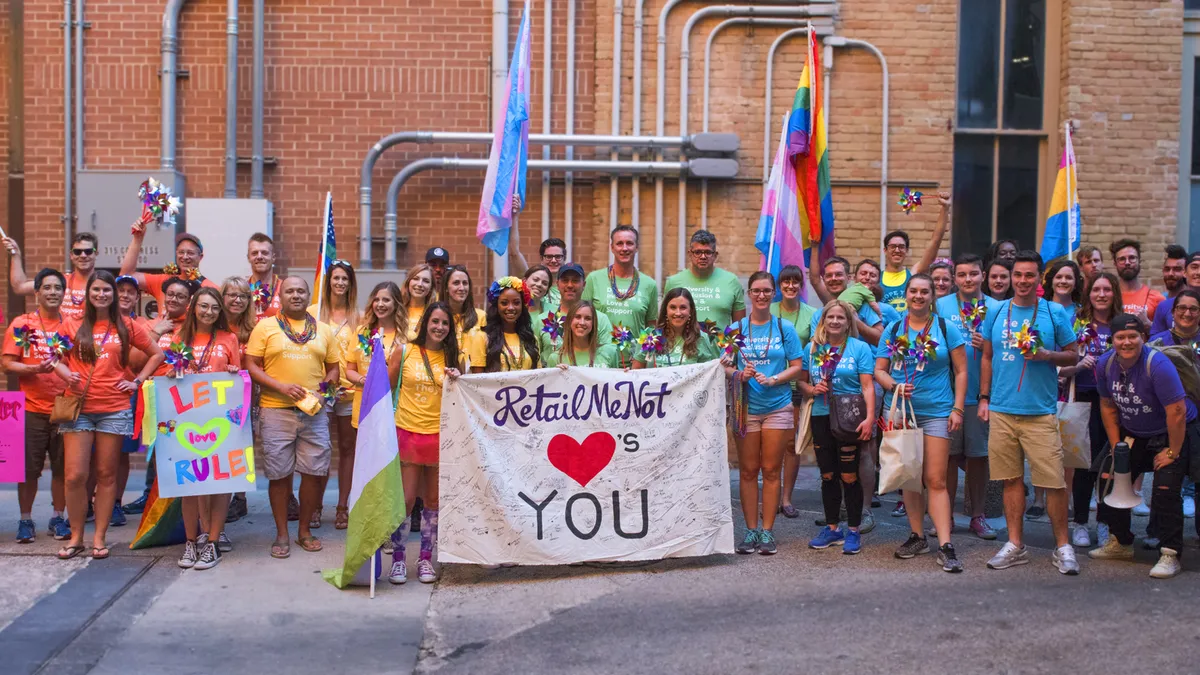As many diversity and inclusion (D&I) professionals struggle to merge programs with company culture, RetailMeNot's Sharon Brogdon is in an enviable position. As the new director of the retail tech company's D&I program, Brogdon joined an organization that is already "walking the talk" in their diversity efforts.
From incorporating diversity and inclusion as a company value in 2016 to earning such accolades as being named one of Austin's Best Places to Work 2018 and a finalist for Austin Mosaic Awards for companies with notable efforts for being inclusive, RetailMeNot bucks the trend of tech companies that have difficulty creating a welcoming environment for all employees.
But being ahead of the curve doesn't mean there aren't still challenges. HR Dive talked with Brogdon to find out what drives her passion for diversity and inclusion, what helps create RetailMeNot's secret culture sauce and what other companies can learn from RetailMeNot's success to move their own D&I efforts forward.
Early influences
As a self-described Army brat growing up on a small base north of Chicago, Sharon Brogdon didn't have to worry much about diversity and inclusion. The military base reflected the country's demographics. "My best friends were a white girl and an Asian girl, and we just played all day and that's all we ever worried about. But once [my sister and I] moved off the base and integrated our elementary school, for the first time, I was not only made to feel different, I was told I was different and I was told that different was bad," she recalled.
The experience of feeling different as one of the few African Americans wasn't limited to elementary school, but was repeated in Brogdon's Navy and corporate career. "Being the 'only' became a way of life for me," she said.
Although Brogdon's career thrived as she worked in different areas of business, that isolation stayed with her. When she had the opportunity to work in D&I at Intel, helping other employees feel less alone, she took it. "When I found the diversity and inclusion organization, I finally had language to apply to my experience and I had an opportunity to make a difference and to help others find language for their experiences too."
Brogdon said that by helping corporations understand the experience of employees who were underrepresented because of gender, ethnicity or other differences, the corporations could help combat that feeling of isolation.
Working in D&I before D&I was cool
When Brogdon first started working in D&I at Intel in 2004, after more than 20 years in various business roles with the company, D&I wasn't the catch phrase it is now. It wasn't always seen as a business imperative, but more the "right" thing to do.
"It was definitely an adventure," Brogdon said about the early days of the program. "We didn't have a path to follow. The interesting thing is that the company was at least open to having a program and we had the opportunity to to do some trailblazing things. It was exciting to me, and also I got to grow in my practitioner expertise as company grew in its program, and to celebrate what did work and hone my experience as the company grew."
At RetailMeNot, inclusion is baked in
When Brogdon considered the move to RetailMeNot, she was drawn to the idea that the tech company had such commitment to inclusion. It wasn't just the welcoming way people greeted each other in the morning. It wasn't just the corporate values hanging on the wall, with diversity and inclusion highlighted as one of the six. It wasn't just talk. "They believed in it so completely, it is a part of who they are as a company and a part of how they want to operate on the day to day, and they truly believe it and totally live it. That was totally intriguing to me," Brogdon said.
Part of the company's history of inclusion was initiated by CEO Cotter Cunningham, Brogdon said. Cunningham's desire was to help people save, she said. "There is that connection to D&I, helping people be better, do better and have better access." He built teams that were empowered, and ensured people's voices were heard, driving innovation through diversity and inclusion, Brogdon added. "That was part of his original vision of who RetailMeNot was," she said.
But the support for inclusion is not just a top-down approach. Today, seven employee resource groups and a cross-departmental D&I council also work to ensure that the cultural efforts are supported at all levels of the organization.
What's next?
With RetailMeNot already on the right track, what's next? Continuing to sustain that culture of inclusion, Brogdon said. Beyond that, the company will look for ways to encourage diversity and inclusion outside of its own walls. "As we take a step back and look at the tech industry as a whole, we really want to be a part of the solution around expanding that pipeline of technical talent," Brogdon said. "When we think about that relatively small pool of diverse technical talent, we want to be a part of expanding that pipeline."
That means building external partnerships with organizations that focus on exposing underserved youth to technology, encouraging them to pursue STEM disciplines. "It will take time, but we really do want to be a part of expanding the technical pool of underserved talent," Brogdon said.
Advice for others
For other employers looking for their own D&I recipe, Brogdon has some tips. The first step is to really listen to employees, she said. It's easy to get caught up in your own view of what D&I is, but to be effective, you need to find out what D&I means to employees, she said. "If you're not living it and listening to what employees say they need, it's easy to put a program into place that doesn't meet their needs."
Next, be willing to have lots of conversations around unconscious bias. "It really starts with helping people become aware that they do have unconscious bias and once they become aware, give them the tools to help them address it," she said. This also means examining systemic processes to ensure all programs and initiatives are inclusive.
But, Brogdon warned, know that diversity and inclusion cannot be dictated, only encouraged. "You're dealing with human beings. You can expose them to bias training. You can help them understand the value add to them individually when you create an environment that is inclusive," she said. Brogdon added that employers may also want to make clear that they're not pushing people out — "it is not a zero sum game."
"Everyone has a role to play in increasing the capacity to have an inclusive environment and when we can achieve that, the company wins," she said. "And when the company wins, everybody wins."
Correction: An earlier version of this story inaccurately portrayed the source's description of the company's D&I program. The story has been updated to reflect that change and HR Dive regrets the error.





















